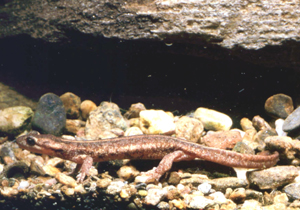Corsican brook salamander facts for kids
Quick facts for kids Corsican brook salamander |
|
|---|---|
 |
|
| Conservation status | |
| Scientific classification | |
| Genus: |
Euproctus
|
| Species: |
montanus
|
The Corsican brook salamander or Corsican mountain newt (Euproctus montanus) is a type of salamander. It belongs to the Salamandridae family. This special animal lives only on Corsica, an island in the Mediterranean Sea. This means it is endemic to Corsica.
You can mostly find the Corsican brook salamander in rocky streams, springs, and rivers. They live in forests and maquis areas. These places are usually high up, over 600 meters (about 2,000 feet) above sea level.
Contents
What Does the Corsican Brook Salamander Look Like?
The Corsican brook salamander is smaller than its relatives. For example, it is smaller than the Sardinian brook salamander. It can grow to about 13 centimeters (5 inches) long. But most of them are around 10 centimeters (4 inches).
Body Features of the Salamander
Its head is long with a rounded snout. The tail is oval-shaped and is as long as the rest of its body. You can see special glands on the side of its neck. These are called parotoid glands.
Male salamanders have small bumps, or spurs, on their back legs. They also have a cloaca that points backward. A cloaca is an opening for waste and reproduction. Female salamanders have a cloaca with an opening on the bottom.
Skin and Color of the Salamander
When the salamander lives in water, its skin is smooth. But when it lives on land, its skin becomes rougher. Its body color is usually brown or olive green. Sometimes, it has spots of orange, red, or brown. These spots are often near its spine.
Its belly is lighter and mostly one color. It might have small white specks. But it does not have spots on its throat. The only other salamander on Corsica is the Corsican fire salamander. That one is easy to spot because it is bright black and yellow.
Where Does the Corsican Brook Salamander Live?
The Corsican brook salamander lives only on the island of Corsica. It does not live in the low eastern areas or near most of the coast. You can find it high up in the mountains, even up to 2,250 meters (about 7,400 feet). It is most common between 600 and 1,500 meters (about 2,000 to 5,000 feet).
Salamander's Water and Land Homes
This salamander mostly lives in water. It likes lakes, ponds, and slow-moving parts of streams. It often hides under stones in the water. When it is on land, it stays close to water. It lives in maquis areas and woods. There, you can find it in the plants or under fallen logs and rocks.
How Does the Corsican Brook Salamander Live?
The Corsican brook salamander needs water with lots of oxygen. It breathes through its skin in the water. It has very small lungs, or sometimes no lungs at all. Even so, it can move around on land. It sleeps underground during the winter. This is called hibernation.
After breeding, it spends some time on land. It is mostly active at night. It eats insects and other small creatures without backbones.
Life Cycle and Reproduction
Near the coast, these salamanders might breed twice a year. This happens in spring and early autumn. But higher up in the mountains, they breed in midsummer.
The male salamander holds the female with his mouth. He wraps his tail around her. Then, he uses his cloaca to put one or two sperm packets into her cloaca. After that, the female lays about 30 large eggs. These eggs have a lot of yolk. She puts them in cracks and under stones. She guards the eggs until they hatch about 50 days later. The young, called larvae, look like tiny tadpoles. They take about 9 months to change into young salamanders. This change is called metamorphosis.
Is the Corsican Brook Salamander Safe?
The Corsican brook salamander is listed as "least concern" by the IUCN Red List. This means it is not in danger right now. Even though it lives in a small area, it is common in the places it likes. Its population is not getting smaller.
Threats to the Salamander
However, there are some things that could harm it.
- Pollution of the streams and lakes where it lives.
- New fish like trout being put into its waters. Trout might eat the salamanders or compete for their food.
- Its home being destroyed. This can split up groups of salamanders.


